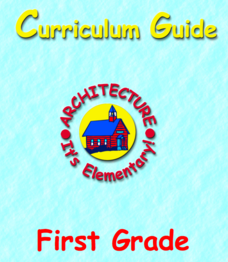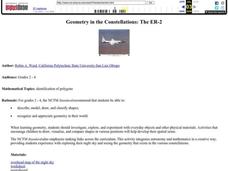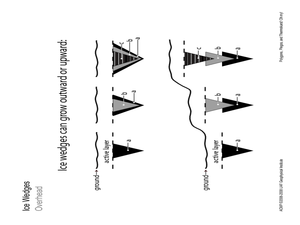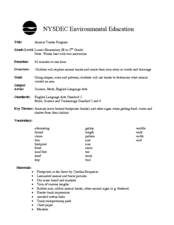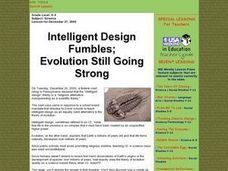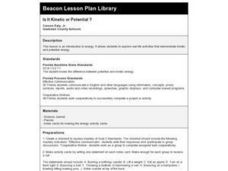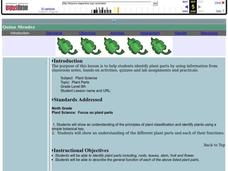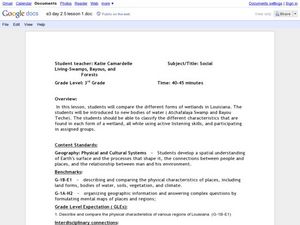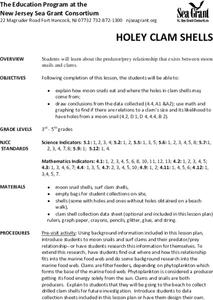Curated OER
Hurricane Shapes: Spatial Patterns on Satellite Images
In this earth science learning exercise, students match 21 hurricane satellite images to their appropriate shape. They also answer 4 short answer questions about hurricane shape classification.
American Institute of Architects
Architecture: It's Elementary!—First Grade
Build an interest and appreciation for architecture in your young learners with this fun 10-lesson art unit. Engaging children in using their five senses, the class first observes the environment around them, paying...
Curated OER
Matters of Milk and Marshmallows
Students observe a teacher demonstration o classifying matter by its physical properties of shape and size. After discussing the definition of matter, students describe the state of matter. They sing a song to the tune of "Bingo." In...
Curated OER
Geometry in the Constellations: The ER-2
Students discuss reasons to record the location of stars. They view a picture of the night sky, and discuss constellations. Students complete a worksheet of the various shapes they see in the constellations.
Curated OER
Balancing The Day Away In Grade 2
Second graders sped the day exploring about balance by playing with and making balancing toys. They discover how varying the amount and position of mass affects the toys' balance. Pupils explore gravity and balance while playing with the...
Curated OER
Polygons, Pingos, and Themokarst! Oh MY!
Students complete activities to learn about the common land features in Alaska. In this land study lesson, students study an overhead for permafrost features. Students define ice wedge polygons, thermokarst, and pingos. Students also...
Curated OER
Classifying Rocks
Students classify rocks into groups after they observe the rocks and identify properties that can be used to divide them into groups. They then identify other properties that could be used to classify other objects into groups.
Curated OER
Seed Sensations!
First graders examine seeds. In this Science lesson, 1st graders classify and dissect seeds. Students sprout their own seeds in the classroom.
Curated OER
Animal Tracks Program
Entice your learners with this lesson on animal footprints. After reading the story Footprints in the Snow by Cynthia Benjamin, they use photos to identify animals and their footprints. Then they participate in an activity to classify...
Curated OER
IPC Chemistry Review
In this chemistry review worksheet, learners classify and name compounds, calculate atomic mass, draw Lewis Dot Diagrams, and determine number of protons for atoms. This worksheet has 37 fill in the blank, 38 matching, and 3 short answer...
Curated OER
Crystals
Students investigate patterns in solids, the structures of crystals and rocks made up of minerals. In this crystals lesson plan, students review solids, make patterns with Styrofoam balls, make crystals in the lab and observe their...
Curated OER
Galaxies
Tenth graders explore the structure and content of galaxies. Through discussion, lab, and hands-on activities, they discover the general structure of the three types of galaxies as well as the effect they have on the structure and...
Curated OER
Jeopardy 8th Grade (Science)
There are so many topics touched upon in this Jeopardy-style science game, that it is difficult to classify! The categories include electricity, matter, ecology, earth and space, and scientific investigation. This would best be used at...
Core Knowledge Foundation
Rocks & Minerals
Take young geologists on an exploration of the rock cycle with this six-lesson earth science unit on rocks and minerals. Through a series of discussions, demonstrations, and hands-on investigations your class will learn...
Curated OER
Matter and Change
In this matter and change worksheet, students answer 24 questions on topics such as elements, compounds, mixtures and chemical reactions. Students answer questions about the properties of matter such as their physical state and shape. In...
Curated OER
Intelligent Design Fumbles; Evolution Still Going Strong
Pupils examine how all life is related and how species are classified. They also discover how traits are passed down from one person to the next. They examine the evolution the arthropod has going through.
Curated OER
Is It Kinetic or Potential ?
Seventh graders explore real life activities that demonstrate kinetic and potential energy. They, in groups, classify the activity card statements as kinetic or potential. They should also include where the potential and kinetic energy...
Curated OER
BREAD IN A BAG
If possible, acquire a handful of wheat kernels from a local farmer or seed dealer. Hand them out so students can feel them and see what they look like. Share background information. 2. Draw a wheat kernel on the chalkboard, or use the...
Curated OER
Plant Parts
Ninth graders identify plant parts by using different classification methods. In this plant lesson plan students observe and draw different types of leaves then classify them according to species.
Curated OER
Rock Identification Lab
Eighth graders compare and contrast the three different types of rock. In this earth science lesson, 8th graders classify rock samples according to their correct rock type. They design their own data collection table.
Curated OER
Living Swamps, Bayous and Forests
Third graders explore interesting environments by exploring Louisiana. In this wetland lesson, 3rd graders utilize the web to research the State of Louisiana, the bayous in the area, and the Gulf of Mexico. Students write a journal entry...
Curated OER
Holey Clamshells
Pupils analyze data to make hypotheses and conclusions regarding the predator/prey relationship between moon snail and surf clams.
Curated OER
What is the Rock Cycle and Its Processes?
Geology beginners examine three different rock samples and determine their origin by their characteristics. By making and recording observations, they become familiar with features of igneous, metamorphic, and sedimentary rock types....
Curated OER
Introduction to Bacteria
Beginning biologists survey several websites to learn about the types, structure, motility, feeding habits, and reproductive methods of bacteria. All websites are linked to the lesson plan, so you can have individuals access it and click...

